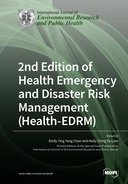Explore

2nd Edition of Health Emergency and Disaster Risk Management (Health-EDRM)
0 Ungluers have
Faved this Work
Login to Fave
Disasters such as earthquakes, cyclones, floods, heat waves, nuclear accidents, and large-scale pollution incidents take lives and incur major health problems. The majority of large-scale disasters affect the most vulnerable populations, which often comprise extreme ages, remote living areas, and endemic poverty, as well as people with low literacy. Health emergency and disaster risk management (Health-EDRM) refers to the systematic analysis and management of health risks surrounding emergencies and disasters, and plays an important role in reducing the hazards and vulnerability along with extending preparedness, responses, and recovery measures. This concept encompasses risk analyses and interventions, such as accessible early warning systems, the timely deployment of relief workers, and the provision of suitable drugs and medical equipment to decrease the impact of disasters on people before, during, and after an event (or events). Currently, there is a major gap in the scientific literature regarding Health-EDRM to facilitate major global policies and initiatives for disaster risk reduction worldwide.
This book is included in DOAB.
Why read this book? Have your say.
You must be logged in to comment.
Rights Information
Are you the author or publisher of this work? If so, you can claim it as yours by registering as an Unglue.it rights holder.Downloads
This work has been downloaded 118 times via unglue.it ebook links.
- 118 - pdf (CC BY) at Unglue.it.
Keywords
- acute mental health needs
- Asia Pacific
- associated factors
- biological hazard
- biological hazards
- Cardiovascular Diseases
- Case study
- cerebrovascular diseases
- Climate Change
- close contact
- cold
- Community mental health services
- Community Resilience
- COVID-19
- cyclone
- Daegu
- disaster
- Disaster Management
- disaster psychiatry
- disaster relief fund
- disaster responders
- DMHISS
- DPAT (Disaster Psychiatric Assistance Team)
- duration of activity
- early phase of pandemic
- elderly
- ensemble prediction
- Europe
- extreme temperature
- Flood
- Fukushima nuclear accident
- H-EDRM
- head and body motion
- Health disparities
- Health EDRM
- Health Risks
- Health-EDRM
- Health-Emergency and Disaster Risk Management
- Home care
- hong kong
- Human behavior
- Hurricane
- indoor environment
- indoor positioning
- infection risk
- infection spread and control
- Internet
- Japan
- kernel density estimation (KDE)
- Kumamoto earthquake
- landslide displacement
- long-term impact
- Mass media
- medicine
- Medicine: General Issues
- Mental health
- multi-case analysis
- n/a
- narrative review
- Natural disaster
- NCD management
- non-communicable disease
- open-plan office
- Pandemic
- personal health protective behaviour
- PHEIC
- predictive uncertainty
- pride
- primary prevention
- probability combination scheme
- psychosocial
- psychosocial impacts
- Public Health
- Public health & preventive medicine
- public health practice
- quantile regression neural networks (QRNNs)
- Risk management
- risk perception
- risk-taking behaviour
- self-care
- sensation seeking
- sense of belonging
- sensor-based
- socioeconomic vulnerability
- strong wind levels
- subtropical city
- Support
- typhoon
- urban
- vector-borne disease
Links
DOI: 10.3390/books978-3-0365-1749-0Editions

